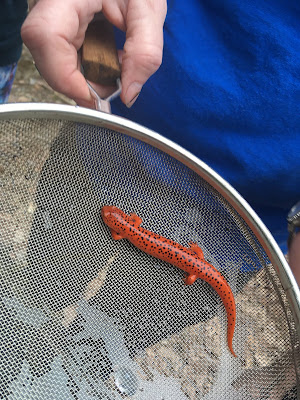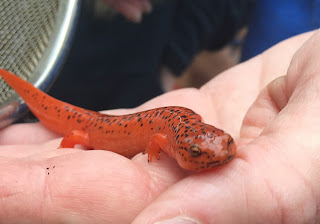As we know, the Appalachians are a global hotspot for salamander diversity, so I was keeping an eye out for some caudate critters. And I didn't have to wait long! The first afternoon, our group spent time dipping sieves in a stream searching for aquatic biota. Several kids quickly found tiny salamander larvae alongside invertebrates like mayfly and dragonfly nymphs and some weird grub thing. The salamander larvae were cool. They were ~3-4 cm in total length, with slender bodies, fluffy gills, and no distinct markings. Unfortunately I didn't take a picture of them. In retrospect, I think they were...
 |
| Pseudotriton ruber found in a mountain stream |
Then something much more dramatic showed up. One of the girls found a beautiful, almost unreal looking salamander in the stream under a rock! This adult red salamander, Pseudotriton ruber, was ~4.5" or ~12 cm long. Besides the gorgeous bright red color, this species is identified by the yellow iris (unlike the brown iris of the closely related mud salamander, P. montanus) and the lack of light line between the eye and nostril (as seen in the spring salamander, Gyrinophilus porphyriticus). Although this individual was fairly large, it may have been a relatively young adult, as older individuals can become more pigmented. Interestingly, it had little of the darker chin markings characteristic of the black-chinned subspecies that is found at this location. I was super excited with this find and took bunches of photos. Some of the kids were excited, too, including the girl who found it - as she should be! - and one boy I'll call Salamander Kid (not my kid; my kid was too busy being obsessed with basketball to care much about salamanders).
 |
| Pseudotriton ruber, note yellow iris |
 |
| Me and my kid at Rainbow Falls |
The herpetological adventure continued the next morning with a hike to Rainbow Falls. The hike was lovely, and we lucked out with great weather. Due to recent rain, the falls and stream were impressively full, so the kids were not allowed to wade in very far. But some were interested in looking in the pools for critters, and Salamander Kid soon announced that he thought he'd seen, yes, another salamander! I couldn't see it clearly as it was mostly tucked under a rock in the water, but SK hung out in that area and kept observing. A bit later when I checked back, the salamander had emerged and climbed up on a moist rock on the other side of the pool. From this vantage, it was clearly a member of the genus Desmognathus, with its chunky hind limbs, somewhat elongate snout, and of course the characteristic light line behind the eye. And it was a good-sized specimen, at least 4.5" or 11-12 cm long.
 |
| Desmognathus quadramaculatus, note light stripe behind eye |
As we know, it can be tricky to differentiate among the species within this genus, but I had a suspicion based on its general look and my previous experience at other Blue Ridge waterfalls. Based on location (always check the range maps!) and the strongly keeled tail, I narrowed it three species, D. fuscus, D. monticola, and D. quadramaculatus. Among these, D. quadramaculatus is the largest and most stout-bodied, with a relatively short tail for the body length. The dark coloration is also a good fit for this species, and although I wasn't able to examine the belly, the photo suggests no evidence of a lighter underside, as would be expected for the other two candidates. Finally, according to one of my favorite online herp resources, D. quadramaculatus is abundant in mountain streams, highly aquatic, yet bold enough to occasionally be seen out in the open. Bingo!
Although I kept an eye - and ear - out for herps for the rest of the trip, all I have left to report are the sweet nocturnal sounds of a few spring peepers and an American toad or two.
We headed out the next day after some morning ziplining, with the growing sense that we would not be returning to normalcy, but to a reality of cancelled plans and kids home from school indefinitely. Contemplating the coming period of hunkering down at home, I was even more grateful to have spent a couple of days breathing the fresh mountain air, making memories with my son, and encountering another side of South Carolina's herpetological diversity.
No comments:
Post a Comment